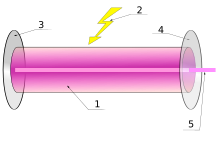
1. Gain medium
2. Laser pumping energy
3. High reflector
4. Output coupler
5. Laser beam
A laser consists of a gain medium inside a highly reflective optical cavity, as well as a means to supply energy to the gain medium. The gain medium is a material with properties that allow it to amplify light by stimulated emission. In its simplest form, a cavity consists of two mirrors arranged such that light bounces back and forth, each time passing through the gain medium. Typically one of the two mirrors, the output coupler, is partially transparent. The output laser beam is emitted through this mirror.
Light of a specific wavelength that passes through the gain medium is amplified (increases in power); the surrounding mirrors ensure that most of the light makes many passes through the gain medium, being amplified repeatedly. Part of the light that is between the mirrors (that is, within the cavity) passes through the partially transparent mirror and escapes as a beam of light.
The process of supplying the energy required for the amplification is called pumping. The energy is typically supplied as an electrical current or as light at a different wavelength. Such light may be provided by a flash lamp or perhaps another laser. Most practical lasers contain additional elements that affect properties such as the wavelength of the emitted light and the shape of the beam.